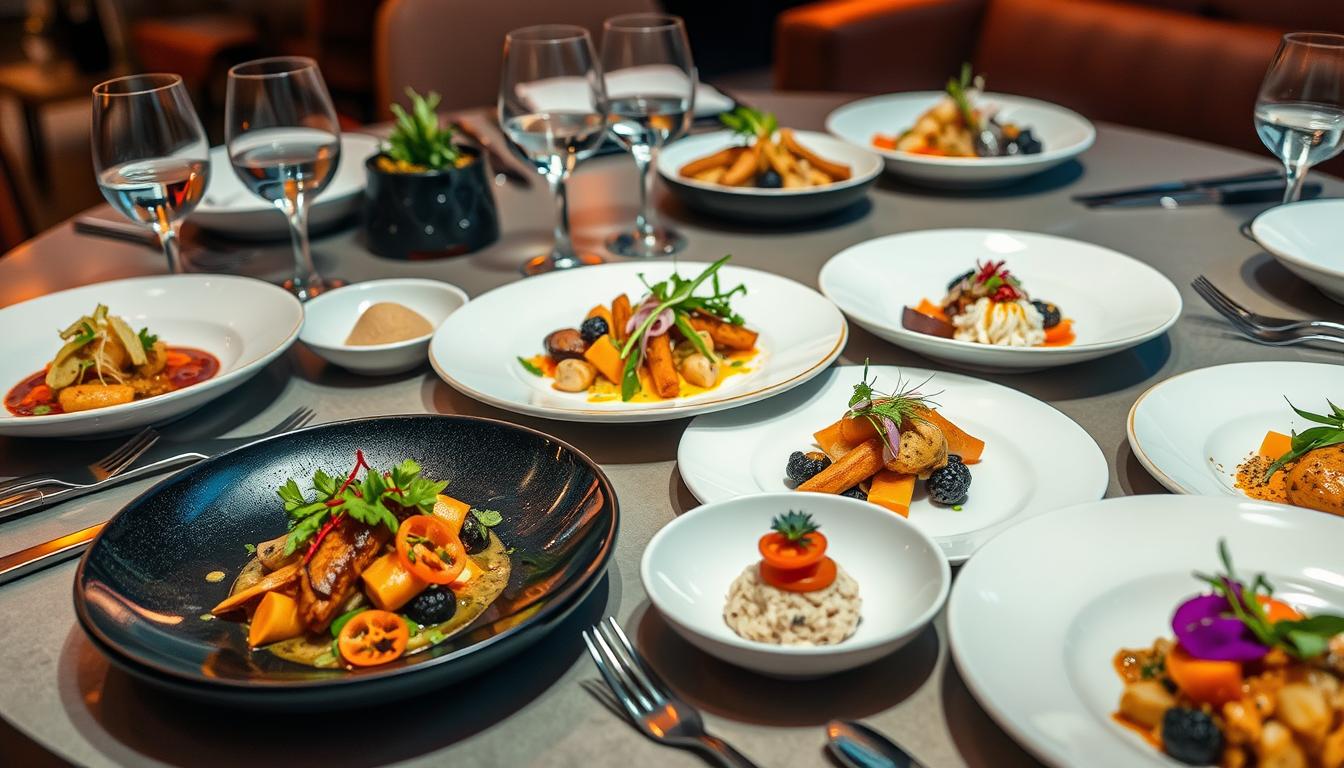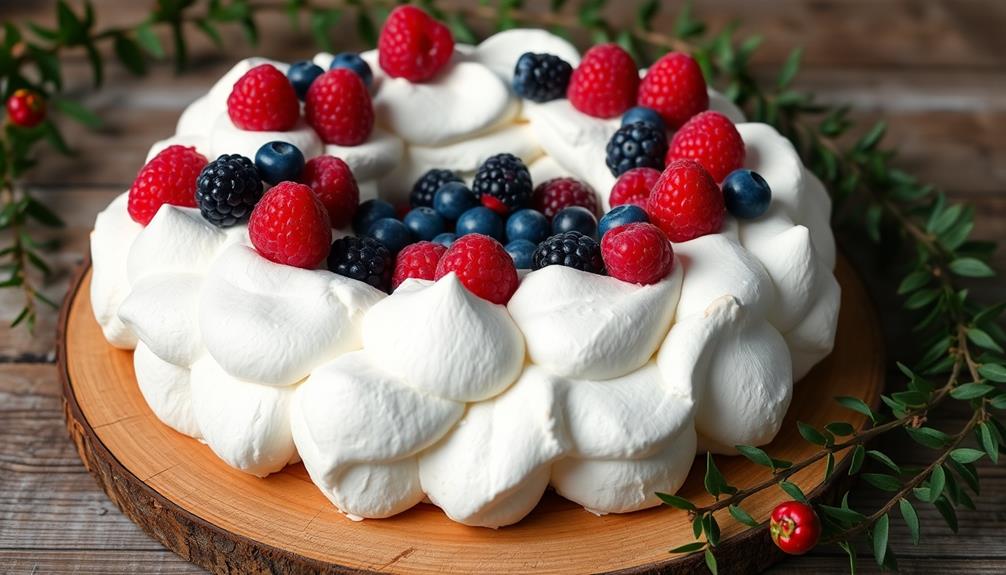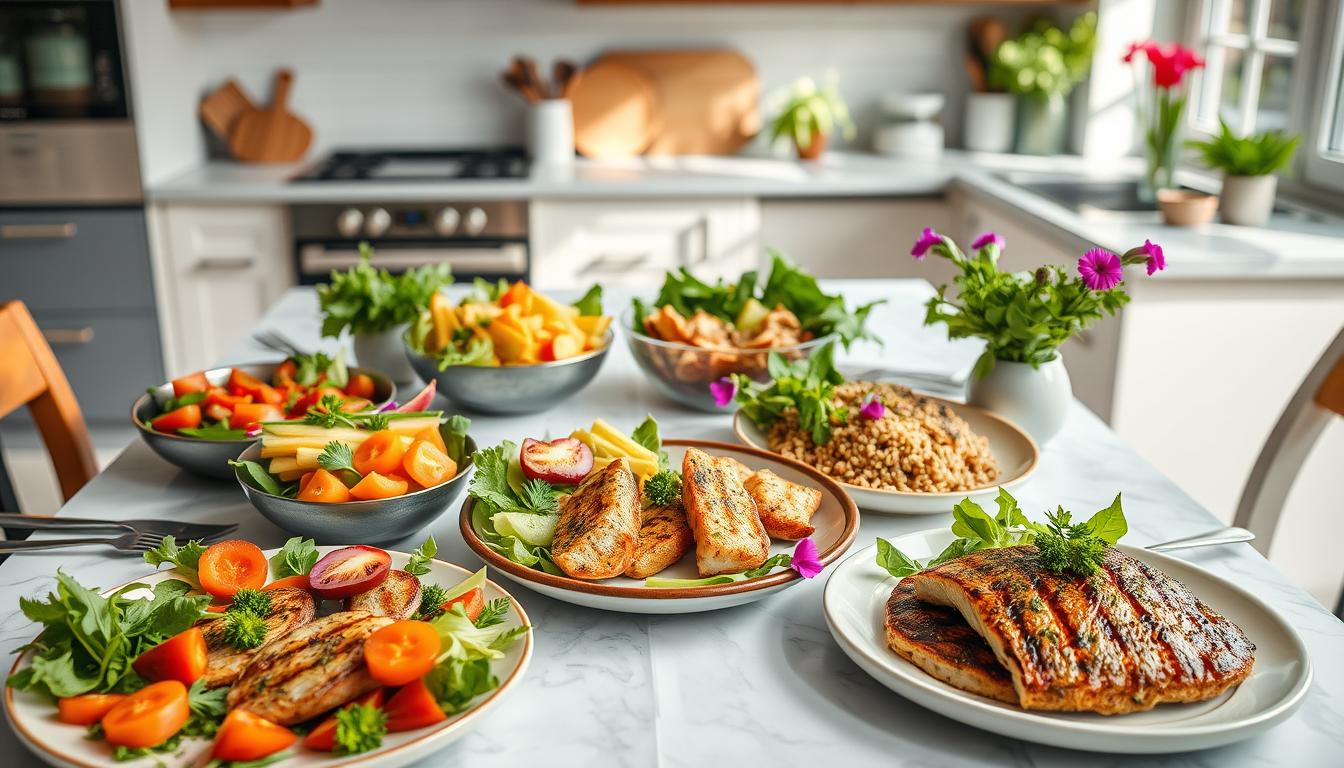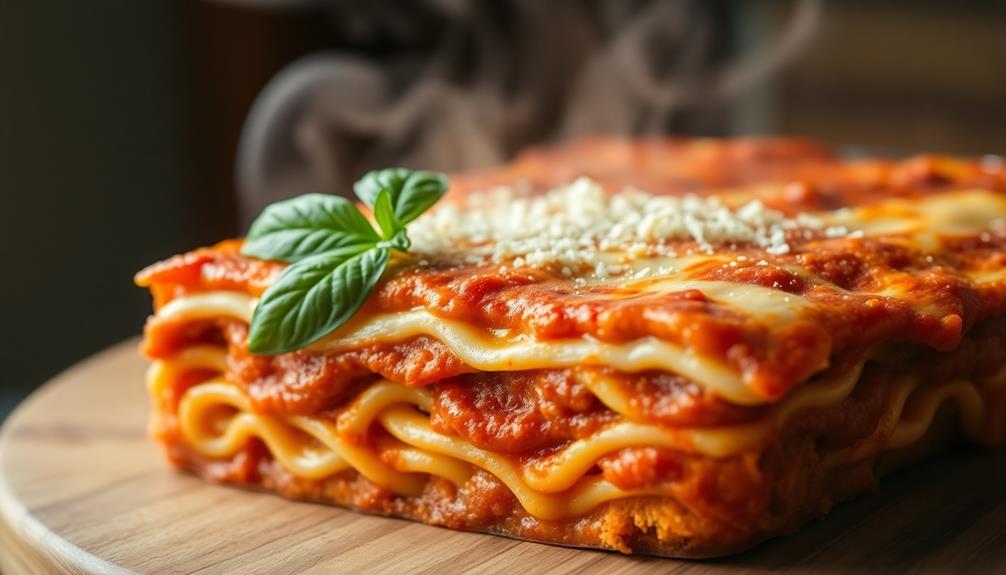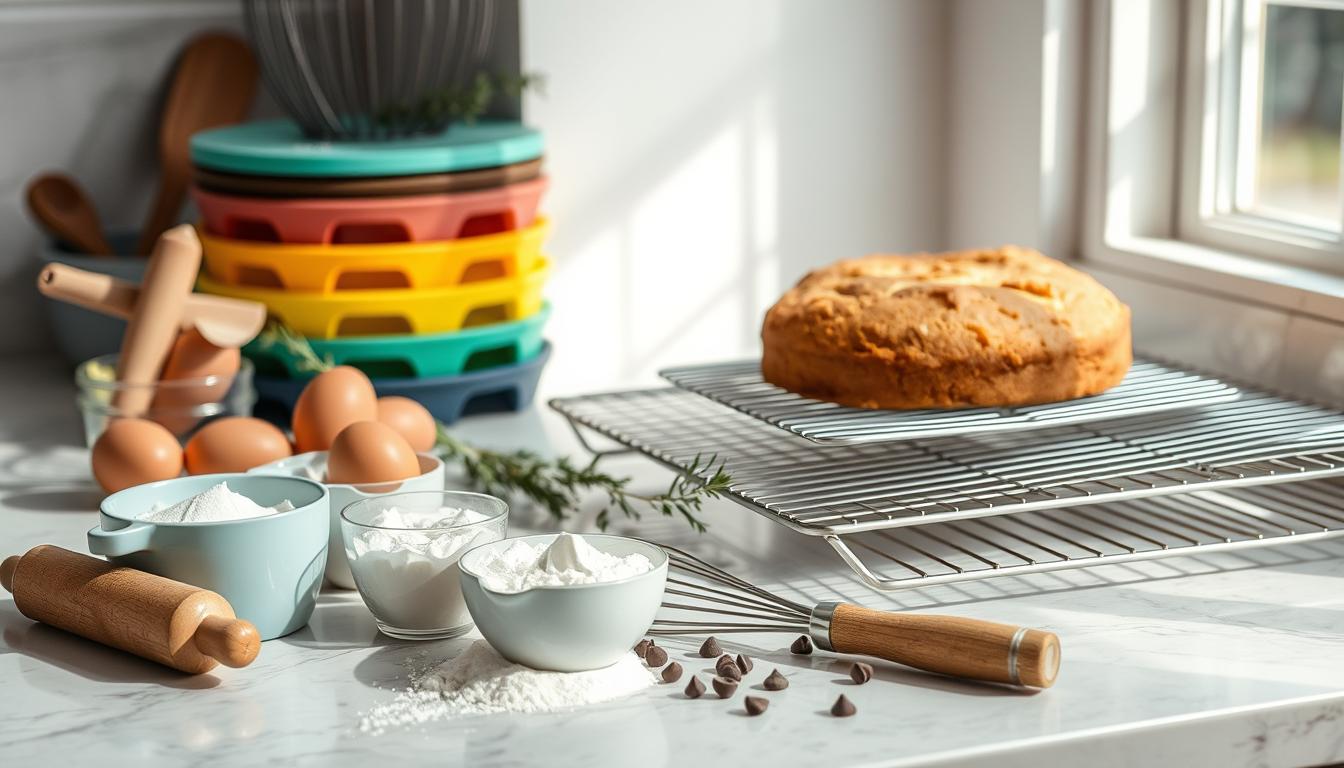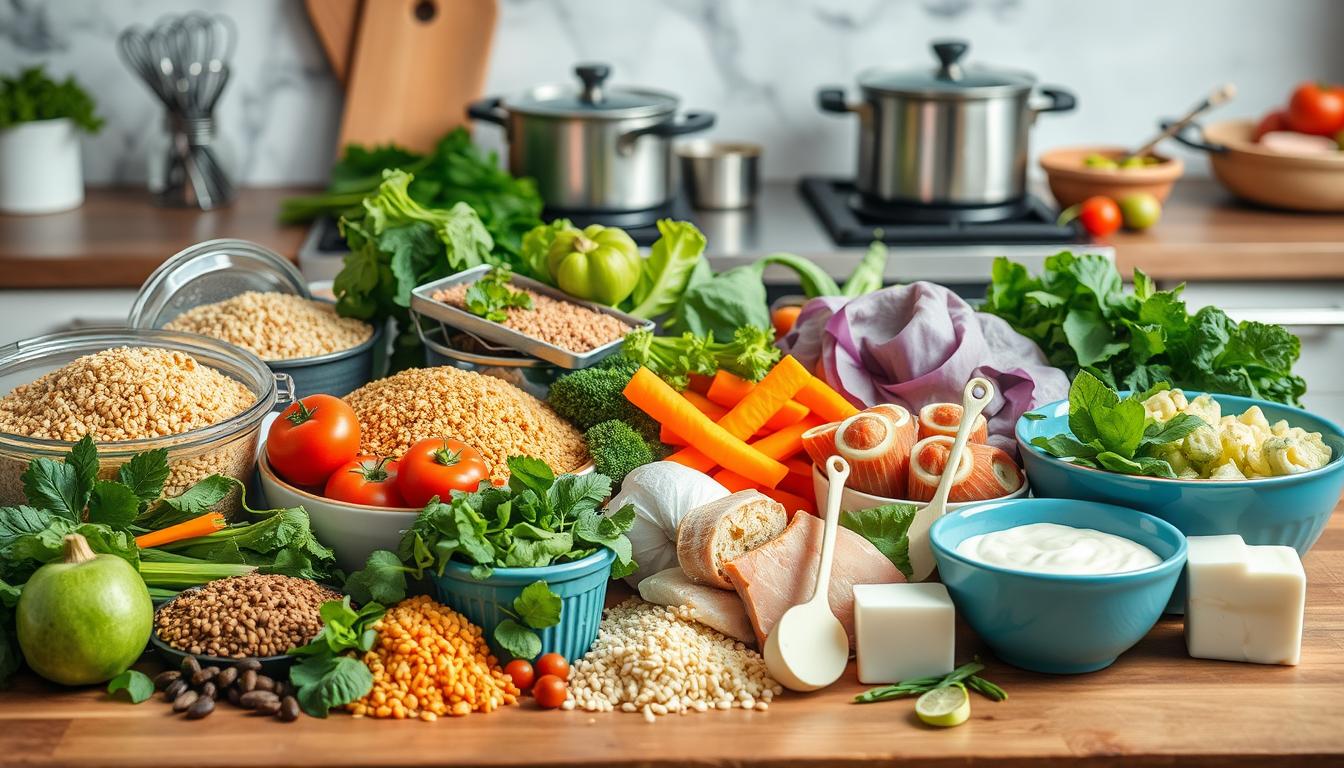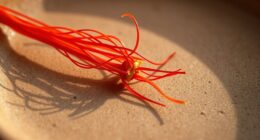Imagine the delight on your guests’ faces as they take their first look at your carefully crafted meal. The aroma wafts through the air, inviting them to savor every bite, but it’s the visual beauty of your dish that truly captivates their attention. Artful culinary presentations can turn an ordinary dinner into an unforgettable experience. When it comes to serving beautifully plated food, you have the incredible opportunity to enhance not only the taste perception but also the emotional connection your guests feel toward the meal. According to a study by Oxford psychologist Professor Charles Spence, diners are often willing to pay more for aesthetically pleasing dishes. So, why not embrace the magic of meal presentation tips and transform your culinary creations into visually appealing dishes that tell a story? With practical techniques and artistic flair, your food will not only feed the stomach but also nourish the soul.
Key Takeaways
- Visually appealing dishes can enhance taste perception and increase perceived value.
- Focus on creating height and dimension with your plating technique.
- Choosing the right plate size and color significantly impacts the presentation.
- Engaging different textures and colors can elevate the overall dining experience.
- Plate garnishes should complement and enhance flavor without overwhelming the dish.
The Importance of Meal Presentation
Meal presentation plays a vital role in how diners perceive their food and overall dining experience. The appeal of a dish is primarily determined by its visual presentation, influencing a guest’s anticipation and enjoyment. Thoughtful arrangement and attention to detail can transform a simple meal into an impressive dining experience that resonates with guests long after they leave the table.
Enhancing Taste Perception
A well-plated dish often creates a powerful impression, significantly contributing to enhancing taste perception. When meals are attractively presented, they are frequently perceived as more flavorful. Research has shown that diners are likely to rate well-arranged dishes as considerably tastier than poorly presented options. Elements such as color contrast, texture variation, and layer structure enhance the visual appeal, prompting diners to anticipate delightful tastes even before taking their first bite.
Creating an Impressive Dining Experience
Engaging the senses through visual stimulation is crucial for memorable dining experiences. Creative food presentation builds excitement and interest in the meal at hand. Utilizing unique garnishes, varying plate heights, and thoughtful color combinations can make a dish stand out. Guests often appreciate a meal that looks as good as it tastes, allowing restaurants to elevate food quality perceptions. Investing in quality presentation techniques can lead to a significant increase in customer satisfaction and willingness to pay more for a dish.

Understanding Food Presentation
Food presentation goes far beyond aesthetics. It plays a crucial role in engaging the senses of your diners. An appealing presentation can elevate the dining experience, creating anticipation and excitement for the meal ahead. Engaging the senses is not only about how food looks; it also encompasses the aromas and textures that enhance the overall enjoyment.
Engaging the Senses
The use of color, height, and arrangement in food presentation can significantly impact how guests perceive their meals. Research indicates that a well-plated dish can boost the perceived value of the food quality, enabling restaurants to command higher prices. Customers are often more willing to pay for meals that visually excite them.
- Color Diversity: Colorful dishes can hint at a complex flavor profile, setting expectations before the first bite.
- Height on the Plate: Creating height adds visual stimulation, encouraging diners to delve into the dish.
- Odd Quantities: Serving an odd number of items, like shrimp or appetizers, can intrigue guests and enhance their experience.
Communicating Quality and Standards
The way food is plated communicates the level of care and quality that went into its preparation. For instance, modern plating methods emphasize the importance of using the right plate color to create appealing contrasts. White plates are often preferred to make food colors pop, while black plates can provide a striking backdrop for vibrant dishes. Earth tones emulate natural aesthetics, creating a warm and inviting visual context.
Applying thoughtful garnishing techniques adds to the plate’s appeal. Edible garnishes should enhance the dish’s overall experience rather than distract from it. Plating techniques, whether classic or free-form, each contribute unique aspects to dining aesthetics. They signal the chef’s attention to detail and commitment to quality.

| Plating Technique | Purpose | Visual Appeal |
|---|---|---|
| Classic | Structured arrangement | Elegance and refinement |
| Free-form | Creative and artistic | Excitement and spontaneity |
| Landscape | Wide, sprawling presentation | Dynamic and inviting |
Key Elements of Great Food Presentation
Understanding the fundamental aspects of food presentation elevates the dining experience significantly. By mastering key elements such as color, texture, and food arrangement, you can transform a simple meal into a masterpiece.
Color
Color plays a vital role in your dish’s appeal. Bright and contrasting colors can stimulate appetite while making the presentation visually impressive. Studies suggest red plates enhance interest in meals, causing guests to linger over appetizers and consider larger entrees. In fine dining, selecting a neutral palette, like classic white china, provides a striking backdrop for vibrant food, enhancing your great food presentation.
Texture
Incorporating various textures creates a pleasant mouthfeel and engages the diner more effectively. Combining smooth components, such as vegetable purées, with crunchy elements, like onion straws, adds depth to your meal. A thoughtful selection of textures not only enhances the taste but also elevates the overall aesthetic of your food arrangement.
Arrangement
The arrangement of food on the plate guides the diner’s eye and influences their experience. Implementing the rule of thirds can help create eye-catching designs, placing the focal point to one side rather than in the center. Balanced presentations, where long items lean against taller elements, create visual harmony. Avoid cluttering with excessive garnishes. A minimalistic approach allows the main components to shine, while well-placed edible garnishes add the final touches of color and texture.

| Element | Impact on Presentation | Best Practices |
|---|---|---|
| Color | Stimulates appetite and attracts attention | Use bright, contrasting colors; consider plate colors |
| Texture | Adds depth and enhances mouthfeel | Combine crunchy and smooth elements |
| Arrangement | Guides the eye and influences perception | Apply the rule of thirds; maintain balance |
Meal Presentation Tips for Eye-Catching Dishes
Creating eye-catching dishes involves thoughtful strategies that enhance visual appeal and elevate the dining experience. By incorporating elements such as height in plating and contrasting colors, you can transform any meal into a work of art that impresses your guests.
Using Height to Add Dimension
Adding height to a dish creates a sense of dimension and excitement. Techniques for achieving this include stacking components or using ring molds. A well-defined vertical presentation enhances the visual appeal of the dish, making simple ingredients appear more elegant. Many chefs in the culinary industry understand the importance of height, as it not only grabs attention but also helps in delivering a balanced overall appearance.
Contrasting Colors for Visual Appeal
Utilizing contrasting colors can significantly boost the attractiveness of your presentations. Dishes featuring vibrant greens alongside rich reds or sunny yellows stand out on a plate. Chefs often emphasize seasonal ingredients, which can add depth and variety to the color palette. Creating these eye-catching dishes enables you to engage diners better, as research shows that 76% of customers are more inclined to order colorful meals. This approach not only energizes the plate but heightens the overall dining experience.

| Presentation Technique | Description | Impact |
|---|---|---|
| Height in Plating | Stacking, overlapping, or using molds | Creates visual interest and elevates simplicity |
| Contrasting Colors | Pairing vibrant ingredients | Draws attention and increases order likelihood |
| Symmetrical Arrangements | Balanced layouts for beauty | Gives an impression of serenity and professionalism |
By mastering these techniques, you not only enhance your culinary presentations but also contribute to a memorable dining experience that can elevate your reputation in the competitive culinary landscape.
Elegant Plating Techniques You Can Master
To elevate your meal presentation, mastering elegant plating techniques is crucial. Techniques like fanning meat and layering ingredients promote sophistication, making your dishes visually appealing and inviting. Properly presented meals not only enhance the dining experience but can increase perceived value, encouraging diners to indulge.
Fanning Meat for Presentation
Fanning meat involves slicing it against the grain and arranging the slices artfully on the plate. This method not only showcases the quality of the meat but also adds elegance to your dish. A beautiful meat presentation can transform a regular meal into a culinary experience that diners remember. By following this method, you can highlight the juiciness and texture of the meat, creating an impressive focal point on the plate.
Layering Ingredients Thoughtfully
Layering ingredients allows you to create a dynamic visual experience for your diners. This technique showcases different components of the dish while adding visual height, making the plate more engaging. Using contrasting colors and textures can enhance the dish’s appeal. As you master layering ingredients, remember to balance the presentation with ample space, avoiding overcrowding to allow each element to shine. A well-layered dish not only looks gorgeous but can also improve the overall perception of flavor.

Creative Meal Display Ideas
A stunning display of food can transform your dining experience, making it not only visually appealing but also memorable. By utilizing unique plates and vessels, you can enhance the overall presentation of your dishes. Experimenting with different shapes and materials keeps your meals exciting and distinct. Pairing these creative meal displays with seasonal ingredients adds both flavor and a dash of color to your plates.
Utilizing Unique Plates and Vessels
Choosing unique plates serves as the first step toward an eye-catching meal presentation. Think outside the box by using:
- Rustic wooden boards for a farm-to-table feel.
- Geometric glassware to bring a contemporary touch.
- Hollowed-out vegetables or fruits as natural vessels for salads and dips.
The materials and shapes you select can enhance the visual impact of your dishes, making your creative meal display truly unforgettable.
Incorporating Seasonal Ingredients
Using seasonal ingredients not only boosts freshness but also vibrancy. As you create your dishes, consider the colors available throughout the year:
| Season | Color Palette | Ingredient Examples |
|---|---|---|
| Spring | Bright greens, pinks | Asparagus, strawberries |
| Summer | Vibrant yellows, reds | Tomatoes, peppers |
| Fall | Warm oranges, browns | Pumpkins, squash |
| Winter | Deep greens, whites | Brussels sprouts, cauliflower |
The bright and earthy tones from seasonal ingredients not only create visual interest but also emphasize the connection between your dishes and their origins, enriching the dining experience.

Garnishing Tips for a Finished Look
Garnishing is a vital element in elevating your meal presentation, turning an ordinary dish into a remarkable culinary experience. Choosing the right edible garnishes can enhance both the visual appeal and the flavor profile of your dish. This section explores effective garnishing tips that you can easily implement at home or in a professional setting.
Choosing Edible Garnishes
When selecting garnishes, ensure they are not only attractive but also complement the dish’s flavors. Fresh herbs like parsley, cilantro, or basil add vibrancy. Edible flowers, such as nasturtiums or pansies, bring a splash of color. These garnishes should fulfill a dual purpose: enhancing presentation while harmonizing with the dish’s taste. Avoid cluttering the plate with unnecessary items; simple, purposeful additions often yield the best results.
Strategic Placement for Maximum Impact
Strategic placement of garnishes can draw attention to key elements of your dish. For instance, positioning a sprig of rosemary or a brightly colored edible flower near a protein not only adds height but also creates visual contrast. Aim to create a focal point that directs the diner’s gaze, enhancing their overall dining experience. Thoughtfully arranged garnishes can also highlight specific flavors, allowing your dish to shine both in taste and appearance.

Tools and Accessories for Professional Food Styling
Having the right tools and accessories significantly impacts your ability to create visually stunning meals. To achieve professional food styling, essential plating tools are necessary. These tools assist in presenting dishes elegantly and artistically, enabling you to attract attention and captivate diners.
Essential Plating Tools
Investing in quality plating tools can transform your food styling endeavors. Consider incorporating the following tools into your kitchen:
- Squeeze bottles: Perfect for precise sauce application, allowing you to create intricate designs or drizzles.
- Tweezers: Ideal for delicately placing garnishes, ensuring a refined touch to your presentation.
- Ring molds: Useful for structuring ingredients, which can help in layering and stacking for an impressive visual effect.
- Chef’s knife: A foundational tool for slicing, mincing, and prepping your ingredients accurately.
Choosing the Right Plates
The selection of plates plays a crucial role in enhancing your meals’ presentation. Here are some considerations for selecting the right plates:
- White plates: These are a favorite among chefs, as they provide a neutral backdrop that highlights the colors of your dishes.
- Red plates: Known to stimulate appetite, these can encourage customers to opt for larger meals.
- Blue dinnerware: Generally avoided because blue foods are rare and can be perceived as unappetizing.
- Unique shapes: Ideal for gastropubs, these plates allow for creative plating ideas that draw attention.
By investing in these plating tools and selecting the right plates, you can elevate your dish presentation. A well-thought-out synergy between your choice of tools and crockery enhances both the aesthetic appeal and overall dining experience.
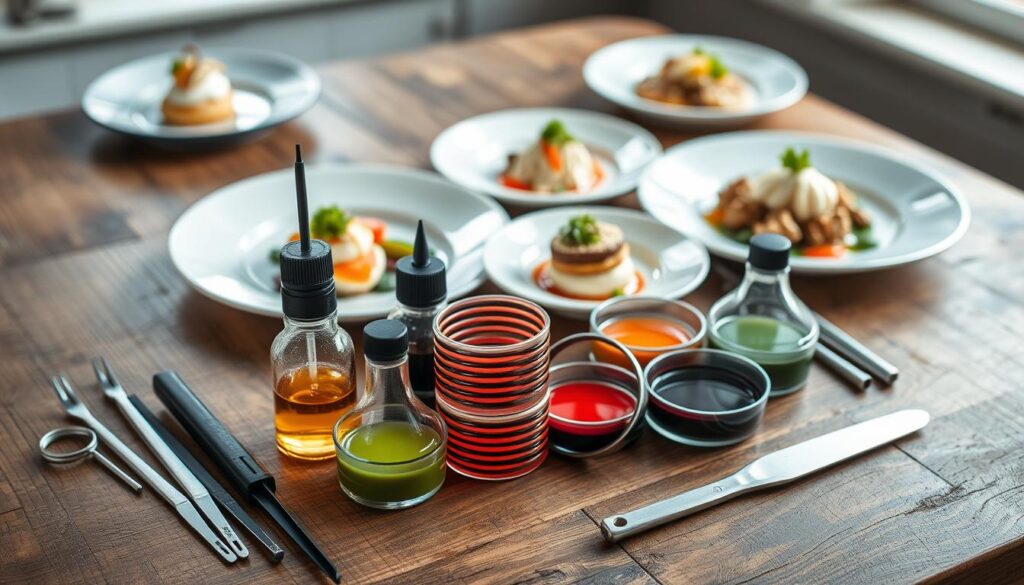
Matching Presentation to Restaurant Theme
Creating a memorable dining experience requires more than just delicious food. It involves aligning your food presentation with the overall restaurant theme. This alignment plays a significant role in appealing to your target audience and expressing your unique brand cohesion.
Understanding Your Target Audience
Deciding on a presentation style starts with understanding who your diners are. Different segments of the dining audience might appreciate various plating techniques. A casual bistro may opt for hearty and uncomplicated presentations, while an upscale establishment will tend toward intricate, thoughtfully arranged dishes. Research shows that diners respond positively to beautifully plated meals, reporting that they perceive them as tasting better. Knowledge of your target audience helps shape these choices effectively.
Creating Cohesion with Your Brand
Your restaurant’s identity shines through in your dish presentations. Consistency across each plate ensures a cohesive image that resonates with your customers. Consider how the colors, shapes, and overall aesthetics of your plating reflect your restaurant theme. Utilizing unique tableware and incorporating textures can elevate the dining experience and reinforce brand cohesion. Thoughtful plating is essential for establishing an inviting atmosphere, where guests feel connected to your culinary philosophy.

Tips for Simple and Effective Plate Decorating Tricks
Enhancing your dish presentation can be achieved through some simple yet effective plate decorating tricks. Utilizing the rule of thirds alongside an understanding of negative space can dramatically elevate any meal. By focusing on these techniques, you can create a more inviting and appetizing display for your guests.
The Rule of Thirds
The rule of thirds serves as a fundamental guideline in food presentation. Imagine dividing your plate into a three-by-three grid, where the focal point of the dish is placed along the intersection points. This technique creates natural balance and guides the viewer’s eye, resulting in a more engaging visual composition. Placing your food artfully off-center not only draws attention but also creates a dynamic appeal, making your meals memorable.
Negative Space in Plating
Incorporating negative space—areas of the plate that remain unoccupied—can significantly enhance your plate’s overall appearance. This technique allows key elements of the dish to stand out, preventing overcrowding and ensuring that each component is recognized. By strategically leaving portions of the plate empty, you invite focus on the vibrant colors and textures of your food. This minimalist approach contributes to an elegant and sophisticated presentation.

| Technique | Description | Benefits |
|---|---|---|
| Rule of Thirds | Dividing the plate into a grid and placing food along intersecting lines. | Creates balance and visual interest. |
| Negative Space | Utilizing empty areas to highlight food components. | Enhances focus on key dish elements, preventing clutter. |
| Color Contrast | Using contrasting colors to make the dish pop. | Increases visual appeal, making the dish more enticing. |
| Layering Techniques | Employing height and texture through layering ingredients. | Adds dimensionality and sophistication to the presentation. |
Plate Size and Its Impact on Meal Presentation
Understanding the role of plate size in meal presentation is crucial for enhancing your dining experience. The right plate not only showcases your culinary creations but also influences how diners perceive your dishes. Selecting an appropriate plate size can transform a meal’s aesthetic, providing a stunning visual treat.
Choosing the Right Plate Size
When it comes to plating, size matters. Larger plates might create an illusion of abundance, while inadequate portions can make meals look sparse. To combat this, it’s vital to consider:
- A balance between portion sizes and plate dimensions to avoid overcrowding.
- Using smaller plates for appetizers to create an elegant atmosphere.
- The shape of the plate; for example, a square plate can offer a modern approach to traditional dishes like lasagna.
Strategically placing vegetables between 12 and 3 o’clock, starches between 9 and 12 o’clock, and meat between 3 and 9 o’clock provides a thoughtful arrangement that enhances the meal presentation impact. Odd numbers of food items tend to draw the eye and create a visually appealing display.
How Plate Color Influences Perception
The plate color significantly affects the perception of the food served. Chefs often opt for white dishes as they contrast nicely with various ingredients, accentuating colors and textures. Dark plates help lighter foods stand out, offering a striking appearance. Combining plate colors with complementary hues from the food elevates the overall dish.
Ultimately, creativity in choosing both plate size and color can enhance the appeal of your meals. Consider materials like metal or glass for a bold, modern presentation. Tailoring these elements to suit the type of restaurant or menu will allow for a more cohesive dining experience.

Conclusion
In the realm of gastronomy, effective meal presentation is a vital ingredient for creating unforgettable dining experiences. By implementing the meal presentation tips discussed throughout this article, you have the opportunity to transform your dishes into artistic food displays that not only appeal to the eyes but also enhance the overall enjoyment for your guests. Remember, the way food is presented communicates volumes about your culinary skills and the quality you provide.
As you strive to elevate your plating techniques, consider how each aspect—be it color, texture, or arrangement—contributes to the viewer’s experience. By doing so, you’ll foster an inviting atmosphere that encourages guests to engage emotionally with their meals, ultimately leading to greater satisfaction and loyalty. Effective presentation goes beyond aesthetics; it’s about telling a story with your food that captivates and entices the diner.
In summary, every meal offers a chance to consciously consider presentation, ensuring that each dish resonates with the true essence of your culinary identity. So, take these insights to heart, and let your creativity flourish as you craft meal presentations that leave lasting impressions. Your efforts can transform dining into a multi-sensory experience, all while enhancing the joy and appreciation for the art of cooking. Consider incorporating fresh ingredient cooking into your meal presentations, as this not only amplifies the flavors and textures of your dishes but also adds an element of vibrancy to the overall visual appeal. With attention to detail and an imaginative approach, your fresh ingredient cooking can become a hallmark of your culinary style, elevating each meal into a memorable and immersive experience for all who partake. Let your passion for fresh ingredient cooking shine through in every presentation, inviting others to savor the beauty and deliciousness of your creations.
